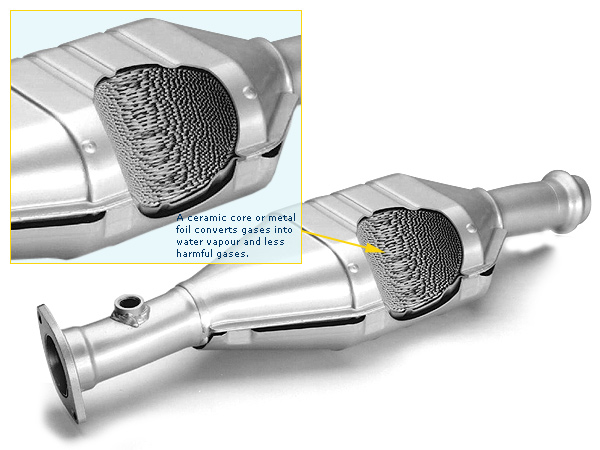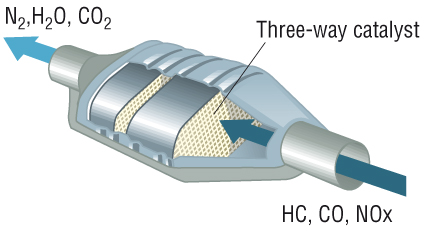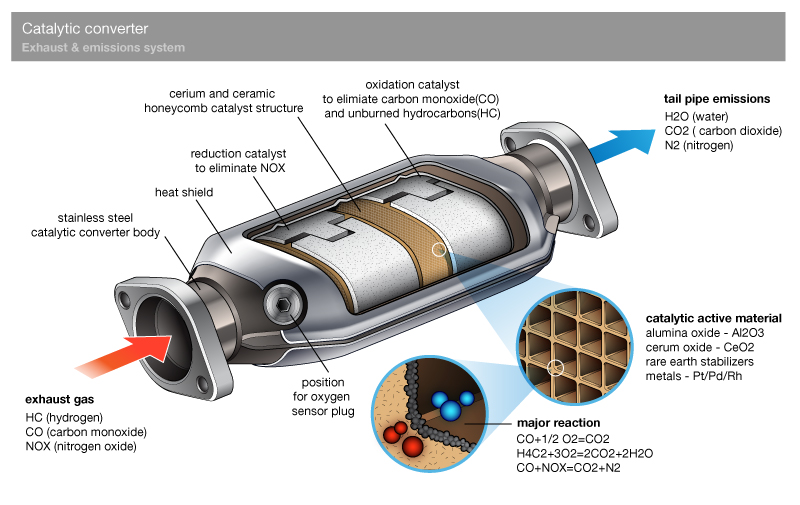Ever Wondered What Is The Purpose Of Catalytic Converter In Your Civic or Corolla?
You might remember seeing Catalytic Converter sticker on the rear glass screen of the previous generation Toyota Corolla and thinking what is it and why is Toyota so proudly showing it off. And then I started hearing my friends saying that their catalytic converter got chocked and they removed, and their cars ended up sounding like they have a punctured exhaust, or Honda dealership cleaned it for them but charged an arm and a leg.
Well to be honest, I also didn’t know what it was until I did some digging. In this article, I will try to explain what I have read and what people have told me about their experiences about this magic box.
First and foremost, it is part of your car’s exhaust system and it has to do with your car’s emissions. When cars turned to Euro standards, we started to notice them. Most people might not even know they had a catalytic converter in their car until it got chocked and the ‘Check Engine’ light illuminated on the dash cluster.
If you have seen a catalytic converter, you might think it is just an ordinary part of the exhaust system, like a resonator or something. But the fact is, it is a very sophisticated piece of technology whose job is to significantly cut down the harmful gases coming out of your exhaust system. After the combustion in the engine, several gases escape from the tailpipe. Among those gases, three are the main culprits. First are the unburnt fuel or hydrocarbons, then there is carbon monoxide or CO, and lastly nitrogen oxides. When these gases escape the combustion chamber after the successful bang, they pass through the catalytic converter. In catalytic converter there is a very sophisticated precious metals coated substrate. Precious metals like platinum, palladium and rhodium. This is when the magic happens. Well truth be told its chemistry, not magic. When these three harmful pass through, the substrate acts as a catalyst and reacts with those gases, changing them into water vapors and carbon dioxide.
Although we in Pakistan only started to get catalytic converters in out cars relatively early, they have been around for quite some time. Before 1980s, the converters were able to only clean unburnt hydro carbons and carbon monoxide. Later, due to more strict emission law, auto makers were asked to raise up their game and clean nitrogen oxides as well, and three way converters were invented and were called three way air catalytic converters. It first cleaned nitrogen oxides and then air was injected in the converter to help it clean CO and HC as well. Since new cars are equipped with clever engine management units, manually injecting air is not required to clean all gases. Modern catalytic converter stores and releases Oxygen when required and works together with the ECU of the car.
Catalytic converters are complex beasts and this article is just to give a brief idea to what their main purpose is and a snippet into their working. There are things like cleaning lean or rich fuel mixtures, then there is hardware components like reduction and oxidation units, and so on. You can go as deep as you want into the subject if you want but for now, we are keeping it brief.
And the answer to the question why they get choked depends on a bunch of factors, but major agent is the petrol sold in Pakistan. It is not good, it is simple as that. The inside of the converter is made up of tiny ducts or honeycomb structure that are laden with precious metals and those ducts start to accumulate carbon and choke when the fuel is not burning efficiently. Only recently, we heard the news about oil companies in Pakistan deciding to upgrade their refineries to produce Euro 2 spec petrol. So until we get better fuel, there are chances you will end with a choked converter.





the main reason for catalytic converter failure is misfires or un-necessarily using hi octane in car…..2nd reason is use of older grades such as api sg,sj,sl etc oils that contain zddp which accumulate in catalytic converter and fail it……..removing it causes more harm than good cause even CEL is not illuminating….chances are that error is stored in ECU and cause problems…..CAT have very long life but above mentioned things fail it…..our fuel is better than america and a lot others…….other thing is that if catalytic converter is cleaned with petrol or carb cleaner which ever mechanics lavishly do then it is destroyed before it is destroyed before it iis put in car……simply remove it carefully in 1 piece without breaking anything and dip it in vinegar for a night or so and then fix it……..bdw recomended action is to replace it but more often its rectified by this method…….do go to these sheeda dholki works etc.
P.S: a failing catylytic converter smells like rotten eggs so if this smell is not present…..more often it can be fixed……
where have you read that hi octane would cause catalytic converter failure? kindly provide evidence when quoting. thanks.
Then which company’s oil do you suggest to use? Up till now we have been using P.S.O’s Carrient version.
using hi octane in regular 10:1 or less than that compression ratio without advancing timing can produce unnecessary unburnt fuel from exhaust…………because if ur engine is tuned to 87 octane which our local cars are then it may cause unburnt fuel from tailpipe……however if u have jdm which is tuned to 91 octane then u can can use 70% regular 30% hi octane to reduce knocking…… otherwise using absolute hi octane is like burning ur money…….anyhow welcome for ur curiosity :)……if u can remap the ecu of ur car for advanced timing for ur civic or corolla then its good and beneficial……otherwise just feeding hi octane without advancing timing is not a good idea……u urself will notice more soot in exhaust and higher CO% and HC% in exhaust after analyzing it when hi octane is fed without advancing timing…..if its advanced then its good or u have moddded ur engine by skimming head,increased ports and using high CR pistons then its absolute necessity for high octane……i hope u understand the concept
using hi octane in regular 10:1 or less than that compression ratio without advancing timing can produce unnecessary unburnt fuel from exhaust…………because if ur engine is tuned to 87 octane which our local cars are then it may cause unburnt fuel from tailpipe……however if u have jdm which is tuned to 91 octane then u can can use 70% regular 30% hi octane to reduce knocking…… otherwise using absolute hi octane is like burning ur money…….anyhow welcome for ur curiosity :)……if u can remap the ecu of ur car for advanced timing for ur civic or corolla then its good and beneficial……otherwise just feeding hi octane without advancing timing is not a good idea……u urself will notice more soot in exhaust and higher CO% and HC% in exhaust after analyzing it when hi octane is fed without advancing timing…..if its advanced then its good or u have moddded ur engine by skimming head,increased ports and using high CR pistons then its absolute necessity for high octane……i hope u understand the concept
for which car and variant???? if its catalytic converter equipped then dont use 20w-50 oil and always use api sm or api sn grade of carrient or any other company..there wud be logo like that on back of oil bottle.
Pakistani high octane has lots of lead to improve ignition, thats it. Our refineries are not capable of producing anything more than 90ron. And the lead causes the cat to choke early than usual.
exactly…..that may be reason…….but as far as i have reviewed spec sheet of pak arab refinery….they have discontinued use of lead in 90s…about other refineries i dnt knw….however mixing of kerosene and water at pumps is normal thing.
Wrong. Hi Octane fuel will not cause Cat-Cons to fail. CONTAMINATED fuel will.
Hi-Octane fuel doesn’t have any advantage in a low-octane tuned engine, but it still burns cleanly and fully unless the engine is running the wrong air/fuel ratio (running “rich”). You dont need to advance or retard ignition time as such for higher octane fuel than the engine’s base rating. Smarter engines can retard their ignition fire timing to adjust to different fuels though.
Fuel that is contaminated with lead or lead derivates will destroy cat converters over time.
you mean ignition timing has no effect on exhausts and emissions????
Modern engines are not that dumb. And ignition paramaters are not THAT slack in engines. An engine will only have unburned fuel in the exhaust if it is running the wrong air/fuel ratio…which happens when MAF sensors are faulty, not by using higher octane fuels.
If you set the engine for 87 RON ignition firing, High-octane fuel will still combust completely but it wont give any added power. As long as the air/fuel ratio is correct, it will burn cleanly.
On the other hand, putting 87RON into an engine with a base tune of 95RON will mean the engine can’t advance the timing enough to prevent premature detonation, and the fuel-air mixture will detonate before the piston can reach it’s TDC peak compression position.
Unburned fuel will remain at the end of the firing stroke if there is too much fuel injected into the engine (which happens BEFORE the piston reaches TDC) or if the ignition timing goes so far out that it’s a half a cycle away from fuel injection. Neither of these occur because you put in a high octane fuel.
For example, my car has an engine which can advance the ignition timing to match RON91, or retard it all the way to RON98. Using RON110 fuel in it (which is commercially available in Australia) doesn’t cause it to leave unburned fuel. It still burns off completely, but there’s no power advantage beyond the maximum compression in the engine. However, if I use RON120, the MAF sensor still thinks it’s RON110.
(Source: Qualified engineer, have carried out research into thermal engineering for university).
Use the oil specified by your car’s manufacturer. Different engines require different oils, and it also depends on climate.
JDMs are tuned to 95 Octane actually. Standard unleaded in Japan is RON95.
no issue for using hi octane in jdm cars …..m talking about local cars perspective….here people feed their cd70 wid hi octane
m not talking about new cars……if ignition timing can be advanced by ecu then no problem……and this only is still managed by cars having knock sensor,CMP and CKP sensor……and these still have limits…..moreover our fuel is also not euro 2 compliant till now
sir if you’re the engineer I pity the future of engineering in Pakistan.
“On the other hand, putting 87RON into an engine with a base tune of 95RON will mean the engine can’t advance the timing enough to prevent premature detonation, and the fuel-air mixture will detonate before the piston can reach it’s TDC peak compression position.”
you mean to say that lower octane fuel requires advanced ignition timing?
*facepalm* hi-octane fuel means it is less reactive, slower to burn, when hi octane fuel is used, it burns slower at stock ignition timing for an engine that doesn’t require hi-octane therefore the output and efficiency declines because the fuel achieves peak energy output when the cylinder has already started going down under its momentum instead of dense energy that could be utilized at tdc in peak compression state..
when you advance ignition timing, the fuel is ignited earlier, therefore it reaches peak explosion right when cylinder is at tdc therefore pushes it pack with greater force.
“For example, my car has an engine which can advance the ignition timing to match RON91, or retard it all the way to RON98. Using RON110 fuel in it (which is commercially available in Australia) doesn’t cause it to leave unburned fuel. It still burns off completely, but there’s no power advantage beyond the maximum compression in the engine. However, if I use RON120, the MAF sensor still thinks it’s RON110.”
an engine advanced timing at higher octane fuel and retards it at lower octane because lower octane fuel is more reactive, burns faster when it is ignited. it produces knock when used with advanced timing because when cylinder is coming up towards tdc and it is ignited and starts to push the cylinder back down, which creates greater pressures and exerts more force on cylinder, con rod and valves. therefore an engine can get destroyed as a consequence of knocking/pinging.
sir any one who studied just the first chapter of organic chemistry of 12th would know that TetraEthylLead is used as octane boosting agent in gasoline. although its usage has been stopped in developed countries it is still used in countries like Pakistan. therefore hioctane is sold as HOBC(Hi Octane Blending Component) instead of RON rating or as 93-95 unleaded. actually it is leaded.
My colleagues have worked with Ford Australia for engine design.
Hi-Octane fuel is NOT slower to burn, it is RESISTANT to DETONATION and auto-ignition under high compression. Its energy density is much the same as any other gasoline-based fuel (except E10 and E85, they have high octane ratings but lower energy densities).
High compression engines actually have retarded ignition timings compared to lower compression engines…they fire the spark plug later than a low-compression engine would, to allow the fuel to reach peak compression.
For example, Mazda’s skyactiv-G engines use a 14:1 compression ratio…they need RON95 fuel. In tests carried out in our labs at the same RPMs, we found the Ford EcoBoost 2L (compression ratio 11.2:1) engine fired its ignition coil a few microseconds earlier than the mazda engine did. And it did so for every single test we did.
When we put in 98RON fuel, the maza engine actually RETARDED its ignition by several additional microseconds and we recorded peak compression of 14.3:1…the Ford did the same thing.
Higher compression engines fire later in the compression stroke than lower ones. And if you use a more knock-resistant fuel, the engine will let it compress a little more still.
Do bear in mind that both the EcoBoost 2L and SkyActivG are new generation engines, not the stone-age engines used by Pakistani assemblers still.
And to boot, my colleagues also did an intentional detonation/knock test…the mazda engine is tuned to 95RON, and when it was fed 85RON fuel, it advanced its ignition to meet a compression ratio of 13:1 before throwing a Check engine light. The ford engine has a base tune of 91RON, and it responded by lowering its compression to 10.55:1 and then throwing a CEL.
ADVANCING ignition timing lowers the compression of the fuel/air mix before ignition…and ignition takes place just before the detonation point. High octane fuels are more resistant to detonation, and compression is allowed to stretch a little more.
PS Before making a personal attack on my education get some real technical facts first. I didn’t become a research student and teaching associate at a world-leading university by reading armchair blogs like most people here on PW write.
TEL has been phased out in much of the developed world since 1986.
The lowest octane fuel available in Australia is 91, Europe 95, Japan 95 and USA 91 as well, all unleaded.
Pakistan…what can we say, our homeland is still stuck in the 70s firmly when it comes to auto technology.
TEL was phased out in Pakistan in 2001
Shell Unleaded is good for cat? I heard only Shell is selling unleaded gasoline in Pakistan. Is that true?